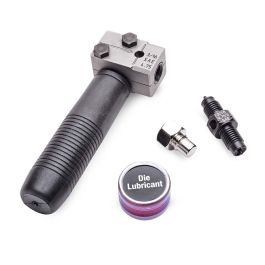LMHmedchem
Well-Known Member
- Joined
- October 28, 2011
- Messages
- 662
- Reaction score
- 118
- Year, Model & Trim Level
- 2002 Explorer XLT v8
Hello,
It appears that I am going to have to do at least some brake line work. There are kits available from sites like,
In Line Tube
but I don't know if that is the way to go or not. These don't seem to include the short lines from the ABS.
Assuming that I am going to buy tubing, bend and flare it, and add my own fittings,
- what size tubing do I need?
- do I go with something like AGS Poly-Armour PVF, or Nickel Copper (I wouldn't use plain steel living around here)
- how many feet of tubing would I need to do everything?
- what size/type of fittings do I need (compatible with the existing master cylinder, ABS, flex hoses, etc)?
- what is a good flare tool (this is dependent on the type of fittings, correct?)?
- do I need a straightener?
I have a cheap tube bender but could get something better.
The first lines I would tackle are the short lines from the ABS to the first junction (one of them is leaking). There seems to be a section of those lines that have a braided covering. Are those flexible lines or just a covering on steel lines?
Thanks again for all the help.
LMHmedchem
It appears that I am going to have to do at least some brake line work. There are kits available from sites like,
In Line Tube
but I don't know if that is the way to go or not. These don't seem to include the short lines from the ABS.
Assuming that I am going to buy tubing, bend and flare it, and add my own fittings,
- what size tubing do I need?
- do I go with something like AGS Poly-Armour PVF, or Nickel Copper (I wouldn't use plain steel living around here)
- how many feet of tubing would I need to do everything?
- what size/type of fittings do I need (compatible with the existing master cylinder, ABS, flex hoses, etc)?
- what is a good flare tool (this is dependent on the type of fittings, correct?)?
- do I need a straightener?
I have a cheap tube bender but could get something better.
The first lines I would tackle are the short lines from the ABS to the first junction (one of them is leaking). There seems to be a section of those lines that have a braided covering. Are those flexible lines or just a covering on steel lines?
Thanks again for all the help.
LMHmedchem











